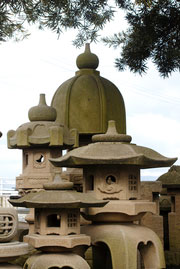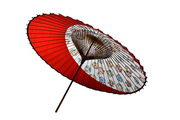Ibaraki and more
- Sort by
- Popularity
- Name
-
Koishiwara ware Koishiwara yaki
- Ceramic
- Fukuoka

Koishiwara ware (called Koishiwara yaki in Japanese) is a form of pottery produced in the Asakura district of Fukuoka prefecture. Since its creation, Koishiwara ware has evolved to become a practical, beautiful pottery. Koishiwara ware's uniq…
View more
-
Mino ware Mino yaki
- Ceramic
- Gifu

Mino ware (called Mino yaki in Japanese) is a ceramic ware produced in the Tono area of Gifu prefecture. It has a long history and tradition but has adapted to modern life style. A notable feature of Mino ware is its wide variety of pottery. Mino …
View more
-
Yuki tsumugi silk Yuki tsumugi
- Woven textiles
- Ibaraki

Yuki tsumugi silk is produced principally in the reaches of the Kinugawa River that straddles the Ibaraki and Tochigi prefectures. The Japanese name Yuki tsumugi comes from the name of a feudal lord during the Kamakura period (1185-1333), Yuki. Al…
View more
-
Hakata doll Hakata ningyo
- Dolls, kokeshi
- Fukuoka

Hakata dolls (called Hakata ningyo in Japanese) are unglazed clay dolls produced in the city of Hakata, in Fukuoka prefecture. The notable features of Hakata dolls are their subtle soft colors, delicately carved expressions, and curves that almost…
View more
-
Kasama ware Kasama yaki
- Ceramic
- Ibaraki

Kasama ware (called Kasami yaki in Japanese) is a form of porcelain produced in the area around the city of Kasama in Ibaraki prefecture. This porcelain has long been considered a traditional souvenir of visiting Kasama Inari shrine (one of Japan&…
View more
-
Kurume traditional resist-dyed textiles Kurume gasuri
- Woven textiles
- Fukuoka

Kurume traditional resist-dyed textiles (Kurume gasuri in Japanese) is a woven cloth produced in and around the city of Kurume, Fukuoka prefecture. The breathability assures coolness in the summer and excellent heat-retaining properties provide wa…
View more
-
Hakata brocade Hakata ori
- Woven textiles
- Fukuoka

Hakata ori refers to the ori or woven cloth produced in and around Hakata, Fukuoka prefecture. Hakata weaving techniques, which originated in China, have shaped this unique cloth. It has been highly regarded for its high quality throughout the age…
View more
-
Mino traditional Japanese paper Mino washi
- Traditional Japanese paper
- Gifu

Mino washi is a type of Japanese paper made in Gifu prefecture. Washi is made from paper mulberry which is a plant that grows in the city of Mino, a place of abundant forests. Ancient manuscripts in the Shosoin Repository* indicate the history of …
View more
-
Agano ware Agano yaki
- Ceramic
- Fukuoka

Agano ware (called Agano yaki) is a form of pottery produced around the town of Fukuchi in Fukuoka prefecture. Agano ware is elegant and lightweight, stemming from its development as a tea bowl for use in tea ceremonies. In some cases, the foot o…
View more
-
Beppu bamboo crafts Beppu take zaiku
- Wood, bamboo crafts
- Oita

Beppu take-zaiku are bamboo crafts produced in the city of Beppu, Oita prefecture mainly from odake bamboo* grown and harvested locally. This craft is entirely handmade and uses a distinctive range of basic weaving techniques. It is also the only …
View more
-
Gifu lanterns Gifu chochin
- Other crafts
- Gifu

Gifu lanterns (called Gifu chochin in Japanese) are produced in the city of Gifu, Gifu prefecture and have a history of over three hundred years. In 1995, their high level of craftsmanship was recognized with a designation as a National Traditiona…
View more
-
Sekishu traditional Japanese paper Sekishu washi
- Traditional Japanese paper
- Shimane

Sekishu washi is a traditional Japanese paper produced in the Iwami region of Shimane prefecture. As an ancient craft, it has a history of around 1300 years. The name Sekishu is found in writings from the Heian period (794-1185). There is also a s…
View more
-
Ichii woodcarvings Ichii itto bori
- Wood, bamboo crafts
- Gifu

Ichii woodcarvings (called Ichii itto bori in Japanese) are produced in the Hida region of Gifu prefecture, and made only from the wood of ichii (Japanese yew), the prefectural tree of Gifu. The ichii tree gets its name from a scepter made of Japa…
View more
-
Unshu abacus Unshu soroban
- Writing tools
- Shimane

Unshu abacuses (called Unshu soroban in Japanese) are produced in the town of Okuizumo, Shimane prefecture. Japanese abacuses are traditional tools that use columns lined with beads that are quickly moved with the fingers to do calculations. They …
View more
-
Banshu abacus Banshu soroban
- Writing tools
- Hyogo

Banshu abacuses (called Banshu soroban in Japanese) are produced in the city of Ono, Hyogo prefecture. Ono, an agricultural area blessed with a warm climate, started abacus production during its off-season. Japanese abacuses are traditional tools…
View more
-
Hida-shunkei lacquerware Hida shunkei
- Lacquerware
- Gifu

Hida-shunkei lacquerware is produced around the city of Takayama in Gifu prefecture. The name is said to come from the fact that the articles produced initially had a similar coloring to Hishunkei tea containers. This craft is notable for having …
View more
-
Tamba-tachikui ware Tamba tachikui yaki
- Ceramic
- Hyogo

Tamba-tachikui ware (called Tamba-tachikui yaki in Japanese) is a form of pottery produced around Konda in the city of Sasayama, Hyogo prefecture. It is one of Japan's Six Ancient Kilns. Together with Bizen, Tamba, Echizen, Seto, and Tokoname…
View more
-
Izushi ware Izushi yaki
- Ceramic
- Hyogo

Izushi ware (called
View more
-
Iwami ware Iwami yaki
- Ceramic
- Shimane

Iwami ware (called Iwami yaki) is a type of pottery produced around the city of Gotsu, Shimane prefecture. Iwami ware is strong, has low water absorbency and is resistant to salt, acid, and alkali which makes it suitable for storing pickled plums …
View more
-
Yame lanterns Yame chochin
- Other crafts
- Fukuoka

Yame Lanterns (called Yame Chochin in Japanese) are a type of lantern craft produced in the region around Yame, Fukuoka prefecture. This craft has a bamboo frame and a fire box with beautifully painted flowers, birds, and plants. The bamboo frame …
View more
-
Nibutani carved wooden tray Nibutani ita
- Wood, bamboo crafts
- Hokkaido

Nibutani Carved Wooden Trays (called Nibutani ita in Japanese) are produced in Biratori, Hokkaido. The origin of the town name, is an Ainu language word for cliff, pirauturu. This craft is known for its patterns like a spiral pattern called moreun…
View more
-
Nibutani bark cloth Nibutani attoushi
- Woven textiles
- Hokkaido

Nibutani Bark Cloth (called Nibutani-attushi in Japanese) is a bark fiber fabric produced in the region surrounding the the town of Biratori, Hokkaido. The term Nibutani originates from niputai which is an Ainu (indigenous people of north Japan) l…
View more
-
Banshu fly-fishing flies Banshu kebari
- Other crafts
- Hyogo

Banshu Kebari are fishing flies used as artificial-bait hooks for fishing, produced in Nishiwaki City, Hyogo Prefecture. They are characterized by their exquisitely fine workmanship; bird feathers wound with silk thread around a small 1cm hook, ad…
View more
-
Banshu-miki cutlery Banshu miki uchihamono
- Metal works
- Hyogo

Banshu Miki Uchihamono are metalwork produced around Miki City, Hyogo Prefecture. Like Shinshu Uchihamono and Tosa Uchihamono, Banshu Miki Uchihamono is renowned as a craft made using molding techniques. These areas are also known as large product…
View more
-
Toyooka wicker crafts Toyooka kiryu zaiku
- Wood, bamboo crafts
- Hyogo

Toyooka Wicker Crafts, called Toyooka Kiryu Zaiku in Japanese, is wickerwork produced around Toyooka City, Hyogo Prefecture. The origins of the craft are found in the baskets woven from Salix koriyanagi, a species of willow naturally growing in th…
View more
-
Yame-fukushima Buddhist altar Yame fukushima butsudan
- Household Buddhist altars
- Fukuoka

Yame Fukushima Butsudan are Buddhist altars made in Yame City (former Fukushima Town), Fukushima Prefecture. Dotted with many temples, the Yame region had been a place where there were many devout Buddhists since ancient times, which supported the…
View more
-
Makabe stone lanterns Makabe ishidoro
- Stonework
- Ibaraki

Makabe Ishitoro is the Japanese name for Makabe stone lanterns produced around the town of Makabe in the Ibaraki Prefecture. Production of this traditional craftwork started during the Kamakura period (1185-1333). The stone industry in the Makabe …
View more
-
Izumo stone lanterns Izumo ishidoro
- Stonework
- Shimane

Izumo stone lanterns are stone lanterns produced in the city of Sakai Minato in the Tottori prefecture, and in the cities of Matsue and Izumo in the Shimane prefecture. They are made of Kimachi stone, fine-grained tuffaceous sandstone quarried fro…
View more
-
Gifu Japanese Umbrellas Gifu Wagasa
- Other crafts
- Gifu

Japanese umbrellas are not only used on rainy days or as parasols, but there are also umbrellas used for dancing and larger parasols called nodategasa used for outdoor tea ceremonies. They become very slim and delicate when they are closed, and t…
View more
- 1































































































































































































































































































